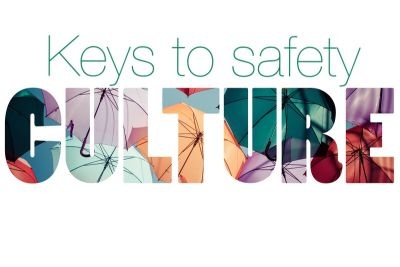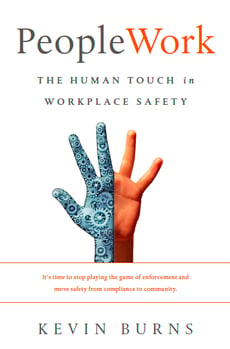The M4 Method is meant to directly help supervisors and safety people build on-the-job relationships that support safety from the ground up.
 Focus on enforcement and your people are focused on rules. Focus on helping people integrate safety into their lives and they focus on being part of the safety solution. Different tactic, different outcome. But so much time, effort, and money is wasted on enforcement tactics because so little time is spent on encouraging employees to buy into safety. The energy spent on enforcement could be better spent building teamwork, morale, and camaraderie.
Focus on enforcement and your people are focused on rules. Focus on helping people integrate safety into their lives and they focus on being part of the safety solution. Different tactic, different outcome. But so much time, effort, and money is wasted on enforcement tactics because so little time is spent on encouraging employees to buy into safety. The energy spent on enforcement could be better spent building teamwork, morale, and camaraderie.
A team that has adopted safety as a personal value is better equipped to make the kinds of decisions on the job to ensure safety. Instead of mere compliance with procedures, programming, and production, a safety-oriented crew draws from a deep well of mutual caring and connection. When crews themselves become safety leaders, the need for safety cops disappears. What you have instead is a team of solid safety leaders who perform and produce at a higher level.
In my book PeopleWork: The Human Touch in Workplace Safety, I present The M4 Method for improved safety culture. It’s a way of integrating people into the strategy of building solid safety programs. The M4 Method is meant to directly help supervisors and safety people build on-the-job relationships that support safety from the ground up.
The M4 Method marries four critical components to achieve the next level of your organizational safety culture:
1Management - an essential skill that inexperienced supervisors and safety people tend to lack. Many ascend to their jobs without rudimentary management and people skills. Supervisory staff who are poorly equipped to manage their crews wind up flailing about with nothing to fall back on but the rules. They struggle because they miss the key component: people skills. When people skills are present, the results can be astounding. Good supervisors and safety people can create a support system that builds trust in their crews, to motivate them on the job, and to get employees to buy into safety.
2Meetings - which are legally required by the Occupational Health and Safety Code. Given the legal requirement to meet regularly, you’d think that safety meetings would help establish significant connections among safety people, supervisors, and crews. Yet so much of that potential is often squandered. Safety meetings should be used to inspire employees, create dialogue, build trust and camaraderie. They should be used to help remove the mental barriers to embracing safety as a personal value. Safety meetings should be opportunities to strengthen and connect with teams. Each meeting is a chance to change the “group-think” on safety. When people are focused and engaged in the shared responsibility of their own work, they become energized.
3Marketing - we don’t usually think of marketing as having anything to do with safety, but they are connected. Marketing is all about communication, and communication involves getting a message across. When it comes to workplace safety, the message needs to carry across all groups of people. To do that effectively requires a solid marketing strategy. Just like marketers who sell products, safety people and supervisors need to sell the idea of safety. The crews are the target market. (If you think safety should sell itself, you’re wrong. Plenty of products that are needed still require marketing, and lots of it. Think toilet paper, for example.) Marketing of safety needs to inspire people to want to be part of it. The messaging needs to be so clear that employees finally come to the realization that, “I get it. I can buy into that.”
4Motivation - the fourth and most crucial component in The M4 Method. Without motivation, nothing works. Motivation is what gets everything else done. Motivation is what makes people stay on-task and focused on workplace performance. Supervisors who aren’t motivated to reach their crews at the human level will revert to policing and rules enforcement. And if they themselves aren’t motivated, you can be sure their crews won’t be either. What results is a stagnant safety culture. When senior management isn’t motivated about workplace safety there’s high turnover in the ranks. Word gets out that safety is not taken seriously, and high performers look to other companies for employment. Low morale and low motivation go hand in hand. People know that the best place to work is also the safest place to work. Motivation is at the heart of safety culture.
 As we make the shift from process to people our whole way of thinking about safety changes. We move beyond the rulebook and minimum standards to higher expectations. We go from compliance to community. We go from playing the game of enforcement to coaching crews in best practices.
As we make the shift from process to people our whole way of thinking about safety changes. We move beyond the rulebook and minimum standards to higher expectations. We go from compliance to community. We go from playing the game of enforcement to coaching crews in best practices.
All four areas of the The M4 Method are dealt with in detail in the book PeopleWork: The Human Touch in Workplace Safety. There’s even a step-by-step guide of how to create a safety marketing strategy for your own workplace.
Kevin Burns is a management consultant, international thought-leader in workplace safety, and a speaker based in Calgary, Alberta, Canada. Kevin has authored ten books on human performance and safety, including his most recent release, PeopleWork - The Human Touch in Workplace Safety.
©2016 ZeroSpeak Corporation and Kevin Burns.
No part of this post may be reproduced without the expressed consent of the author.


